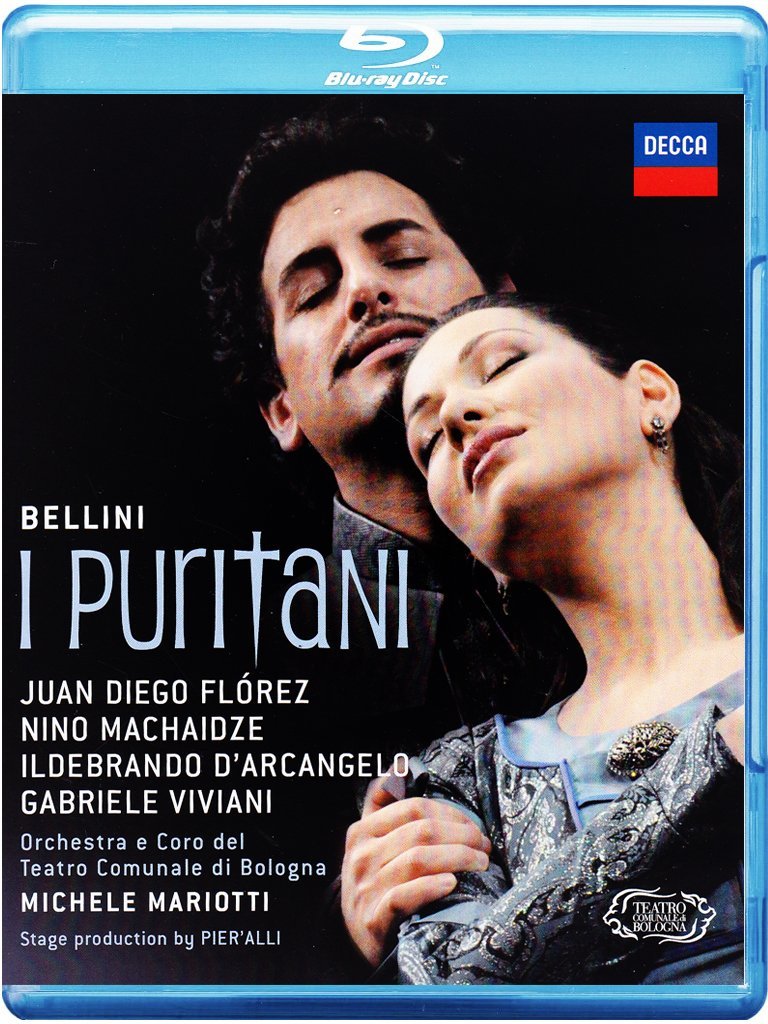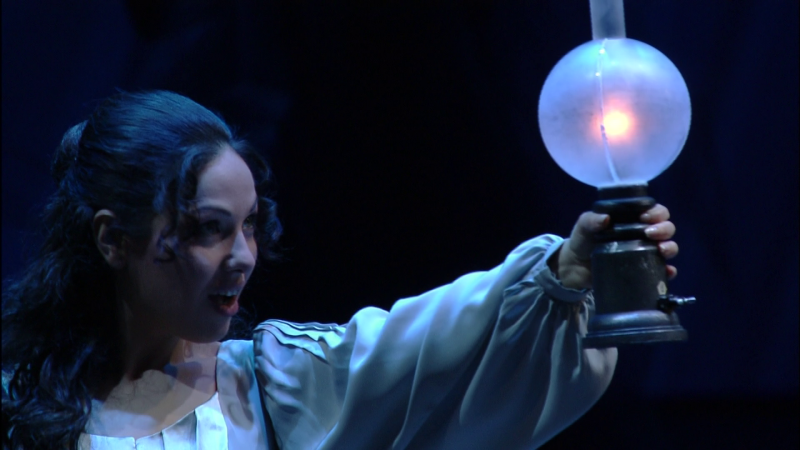

Bellini I Puritani opera to libretto by Carlo Pepoli. Directed 2009 by Pier'Alli (born Pierliugi Pieralli). Stars Juan Diego Flórez (Lord Arturo Talbo), Nino Machaidze (Elvira), Ildebrando D'Arcangelo (Sir Giorgio Valton), Ugo Guargliardo (Lord Gualtiero Valton), Gabrielle Viviani (Sir Riccardo Forth), Gianluca Floris (Sir Bruno Roberton), and Nadia Pirazzini (Enrichetta di Francia). Michele Mariotti conducts the Orchestra e Coro del Teatro Comunale di Bologna. Set and costume design by Pier'Alli; lighting design by Pier'Alli and Daniele Naldi. Directed for TV by Andrea Bevilacqua. Sung in Italain. Released 2014, disc has 5.0 dts HD Master Audio sound. Grade: D
As an amateur opera fan, I have seen live or in HDVD about 225 different opera productions. This Pier'Alli I Puritani has the darkest and ugliest mis-en-scène of any opera I've seen.
When I say "dark" I don't mean "pessimistic." I mean there is next to no light on the stage most of the time. Maybe this was OK in the theater live because the human eye can cope with working in a cave. But it makes for a generally frustrating and depressing experience in the HT (forget showing this with a projector). Many screenshots I wanted to show you turned out to be too dark to use.
By "ugly" I mean costumes, sets, and props that look cheap, shabby, and devoid of beauty. Ugliness here also extends to bad blocking of the star singers and the chorus as well as the lack of cogent acting directions for all personnel on stage.
It would seem the blame for of all this design and directing distress would have to be assigned to Pier'Alli, since he gets official credit for it all. But this would probably be a mistake. I think the director and theater management had a meeting about 2008 when the director was told: "We have contracts with a splendid I Puritani cast. But due to the economic crises and shattered finances of the Italian government, we have almost no money for your production. Use whatever sets, costumes, and props you find in our stores. Rehearsal time is cut 75%, so make it simple. And if your electric bill is more than X, the excess comes out of your retirement plan."
The opera opens with Puritan soldiers reporting for duty:
The Bologna quartermaster found some black uniforms, which is great because the Puritans often wore black. But these soldiers don't look much like Puritans—they look like members of a right-wing death squad in a banana-republic:
And where did they get these hats for the Puritan women? And the only ugly flowers I've ever seen?
Much of the opera consists of protagonists standing on an empty, dark stage singing directly to the audience. Here Riccardo (Gabrielle Viviani) complains about losing Elvira as Bruno (Gianluca Floris) stands nearby listening:
Here's a famous picture of John the Baptist painted by Caravaggio (source: www.caravaggio-foundation.org):
The artist covered John's eyes with a solid black shadow for a tremendous effect, and artists have been copying this ever since. These eye shadows appear so often in this I Puritani that I have dubbed this an illness called Caravaggioitis. Below are just 4 of many, many examples of Caravaggioitis found in this video. First Elvira (Nino Machaidze):
Enrichetta di Francia (Nadia Pirazzini), the widow of the recently-executed King Charles:
Sir Giorgio Valton (Ildebrando D'Arcangelo), Elvira's uncle:
Sir Riccardo Forth (Gabrielle Viviani), Elvir's disappointed suitor:
Here's the scene where Uncle Giorgio tells his beloved niece that she can marry her true love Arturo. This intimate, joyful scene should be done with lots of loving communication between uncle and niece. But here we are off to a bad start with the singers standing 20 feet apart looking in different directions:
Next below is the scene where Arturo, after crossing enemy lines, arrives to greet his bride-to-be. This is the only scene in this production where there is full light on the stage and there is a least a stab at a full-stage set. If you had shown me this picture cold and asked me to guess what's happening, I would have said: "Benito Mussolini gives his daughter's hand in marriage to the general who conquered Ethiopia." Note the chorus members are all making the same choreographed hand gestures. There's no need to create any complicated party scene that must be rehearsed multiple times. Just give the chorus some ritualistic movements they can practice on their own off the clock:
There are a few (fleeting) pretty moments in this reunion scene. Here we get a close-up of Arturo (Juan Diego Flóres):
The star singers in this production were all excellent. Flóres and D'Arcangelow were, of course, the most famous. For some perverse reason the sound recording of both Flóres and D'Arcangelo is unacceptably weak and strained throughout the whole show until deep in Act 3, when suddenly you can hear Flóres better. Were these stars sick on recording day? Were there problems with mikes, mixing, and editing? We will never know:
Now we come to the scene where the widow of the executed king puts on Elvira's veil in an attempt to escape the Puritan fort. Pier'Alli had the benefit of the latest I Puritani scholarship, and he did an excellent job of making the plot of the libretto as logical as possible. By casting a young and trim woman as the Oueen (thought by the Puritans to be a mysterious Royalist sympathizer), Pier makes easy for us to accept the plot. Arturo runs off with the Queen to save her life. But because the Queen is young and pretty, Elvira has good reason to believe that Arturo came to the Fortress not to marry Elvira, but because he was in love with the mysterious stranger. The shock of this betrayal leaves Elvira in a state of madness until the end of the opera when she finally learns the truth. (In the famous Met production of I Puritani with Anna Netrebko, the King's widow is ugly, looks about 60, and might be 100 pounds overweight. Elvira couldn't think that Arturo was in love with that Henrietta, and that's a real problem with the way the Met handles the plot.)
Elvira is jilted and slipping fast into madness. There are lots of people on the stage, but she's all by herself in a cheap gray dress and some costume-quality jewelry:
And a big mouth:
Next comes the famous mad scene. Nino is now even more isolated and without support. There's no set, no magnificent staircase, no veil, no flowers, and another cheap gown—the whole production has to be carried solely by Nino and her lungs:
Well, there's a line in the mad scene about the moon. That inspired the props department to come up with this brilliant idea in aid of their soprano:
Netrebko sang upside down at the Met. So any other Elvira under age 40 has to at least lie on the floor for a few seconds. Nina complies, and her dress pops open exposing her midriff:
Elvira's madness doesn't kill her, and eventually Arturo comes back. This is a relief to Elvira and to us, because now we can suddenly hear Flórez quite well:
The end of the final love duet. Everybody can fall to their knees in gratitude that it's over. There's a curtain call. But I'm all but certain that this video was shot at a dress rehearsal or a special run to an empty house and that the applause is all dubbed in. The cameramen made a lot of shots in this that could not have been done, in my opinion, at a live show. There is one brief segment where we see about 13 boxes with nobody home. Conductor Michele Mariotti has the silliest adolescent grin on his face you could imagine—while soaking up the adulation of the audience that isn't there. In this opera performance, nobody shows acting ability.
So what grade does this earn? The Bologna Opera did assemble an outstanding cast who sang well, much of which you could hear well some of the time. The Bologna Opera and Chorus don't sound as good as, say, the Met musicians. But they do know how to do Bellini well enough to be enjoyable notwithstanding the horrors of the unbalanced sound, bad video, grim design, lack of directing, and lack of acting. I personally don't think this show should have been published, which would result in an F grade. But who am I to condemn so harshly so many famous people and the Decca label, which used to have a reputation for good quality and maybe still does. I have shown enough screenshots here to give you a good idea about Pier'Alli's directing and design objectives. Maybe there's something profound and wonderful going on here that I've missed but others will appreciate. So I'll give this a D and see what happens.
OR
























